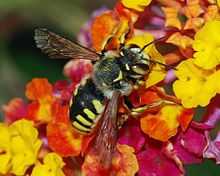Anthidium
| Anthidium Temporal range: Priabonian to Recent | |
|---|---|
 | |
| Anthidium florentinum | |
| Scientific classification | |
| Kingdom: | Animalia |
| Phylum: | Arthropoda |
| Class: | Insecta |
| Order: | Hymenoptera |
| Family: | Megachilidae |
| Subfamily: | Megachilinae |
| Tribe: | Anthidiini |
| Genus: | Anthidium Fabricius, 1805 |
Anthidium is a genus of bees often called mason or potter bees, who use conifer resin, plant hairs, mud, or a mix of them to build nests. They are in the family Megachilidae which is cosmopolitan in distribution and made up of species that are mostly solitary bees with pollen-carrying scopea that are only located on the ventral surface of the abdomen. Other bee families have the pollen-carrying structures on the hind legs. Typically species of Anthidium feed on pollen and nectar from plants, though some species are robber bees that take food from other bees. Anthidium florentinum bees are distinguished from most its relatives by yellow or brick-red thoracic bands. They fly all summer and make the nests in holes in the ground, walls or trees, with hairs plucked from plants.
Most Anthidium species are leaf-cutting bees who use conifer resin, plant hairs, earth, or a combination of these as material for the nest walls. Their abdominal bands are usually interrupted in the middle. There is no lobe (arolium) between their claws. Anthidium manicatum is commonly known as the wool carder bee which uses comblike mandibles to "comb" plant fibers into its brood cell walls. It has spread from Europe to North and South America. The males are much larger (ca. 18 mm) than the females (ca.12 mm) which is not uncommon among Megachilidae, but very rare among other bee families (e.g., the true honey bees, genus Apis). The males also have three "thorns" at their abdominal apex which they use as weapons when defending their territory.
Species
The following is an incomplete list of species and four species have been described from the fossil record. The oldest species date from the Priabonian to Rupelian deposits of the Florissant Formation, Colorado.[1][2]
- Anthidium abjunctum
- Anthidium afghanistanicum
- Anthidium akermani
- Anthidium albitarse
- Anthidium alsinai
- Anthidium alticola
- Anthidium amabile
- Anthidium amurense
- Anthidium andinum
- Anthidium anguliventre
- Anthidium anurospilum
- Anthidium ardens
- Anthidium armatum
- Anthidium atricaudum
- Anthidium atripes
- Anthidium auritum
- Anthidium aymara
- Anthidium aztecum
- †Anthidium basalticum Zhang, 1989[2]
- Anthidium banningense
- Anthidium banningenses
- Anthidium barkamense
- Anthidium basale
- Anthidium bechualandicum
- Anthidium berbericum
- Anthidium bicolor
- Anthidium bifidum
- Anthidium bischoffi
- Anthidium brevithorace
- Anthidium callosum
- Anthidium caspicum
- Anthidium chilense
- Anthidium christianseni
- Anthidium chubuti
- Anthidium cingulatum
- Anthidium clypeodentatum
- Anthidium cochimi
- Anthidium cockerelli
- Anthidium collectum
- Anthidium colliguayanum
- Anthidium comatum
- Anthidium conciliatum
- Anthidium cordiforme
- Anthidium cuzcoense
- Anthidium dalmaticum
- Anthidium dammersi
- Anthidium danieli
- Anthidium decaspilum
- Anthidium deceptum
- Anthidium diadema
- Anthidium echinatum
- Anthidium edwardsii
- Anthidium edwini
- Anthidium emarginatum
- Anthidium eremicum
- Anthidium espinosai
- †Anthidium exhumatum Cockerell, 1906[2]
- Anthidium falsificum
- Anthidium flavolineatum
- Anthidium flavorufum
- Anthidium flavotarsum
- Anthidium florentinum
- Anthidium formosum
- Anthidium friesei
- Anthidium fulviventre
- Anthidium funereum
- Anthidium furcatum
- Anthidium garleppi
- Anthidium gayi
- Anthidium gratum
- Anthidium gussakovskiji
- Anthidium hallinani
- Anthidium helianthinum
- Anthidium himalayense
- Anthidium igori
- Anthidium illustre
- Anthidium impatiens
- Anthidium incertum
- Anthidium isabelae
- Anthidium jocosum
- Anthidium kashgarense
- Anthidium kashmirense
- Anthidium klapperichi
- Anthidium kvakicum
- Anthidium laeve
- Anthidium larocai
- Anthidium latum
- Anthidium loboguerrero
- Anthidium longstaffi
- Anthidium loti
- Anthidium luctuosum
- Anthidium luizae
- Anthidium maculifrons
- Anthidium maculosum
- Anthidium manicatum
- Anthidium masunariae
- Anthidium moganshanense
- Anthidium montanum
- Anthidium montivagum
- Anthidium mormonum
- †Anthidium mortuum (Meunier, 1920)[2]
- Anthidium nigerrimum
- Anthidium nigroventrale
- Anthidium niveocinctum
- Anthidium nursei
- Anthidium oblongatum
- Anthidium opacum
- Anthidium ordinatum
- Anthidium orizabae
- Anthidium paitense
- Anthidium pallidiclypeum
- Anthidium palliventre
- Anthidium palmarum
- Anthidium paroselae
- Anthidium perplexum
- Anthidium penai
- Anthidium peruvianum
- Anthidium philorum
- Anthidium placitum
- Anthidium politum
- Anthidium pontis
- Anthidium porterae
- Anthidium psoraleae
- Anthidium pulchellum
- Anthidium pullatum
- Anthidium punctatum
- Anthidium quetzalcoatli
- Anthidium rafaeli
- Anthidium rodecki
- Anthidium rodriguezi
- Anthidium rotundoscutellare
- Anthidium rotundum
- Anthidium rozeni
- Anthidium rubricans
- Anthidium rubripes
- Anthidium rubrozonatum
- Anthidium rufitarse
- †Anthidium scudderi Cockerell, 1906[2]
- Anthidium sanguinicaudum
- Anthidium semicirculare
- Anthidium senile
- Anthidium septemspinosum
- Anthidium sertanicola
- Anthidium severini
- Anthidium sichuanense
- Anthidium sikkimense
- Anthidium sinuatellum
- Anthidium soikai
- Anthidium soni
- Anthidium sonorense
- Anthidium spiniventre
- Anthidium striatum
- Anthidium sublustre
- Anthidium sudanicum
- Anthidium syriacum
- Anthidium taeniatum
- Anthidium tarsoi
- Anthidium taschenbergi
- Anthidium tenuiflorae
- Anthidium tergomarginatum
- Anthidium ternarium
- Anthidium tesselatum
- Anthidium thomsoni
- Anthidium toro
- Anthidium trochantericum
- Anthidium undulatiforme
- Anthidium undulatum
- Anthidium unicum
- Anthidium utahense
- Anthidium venustum
- Anthidium vigintiduopunctatum
- Anthidium vigintipunctatum
- Anthidium weyrauchi
- Anthidium wuestneii
- Anthidium zadaense
- Anthidium sp. aff. A. atripes
- Anthidium sp. Cham
- Anthidium sp. Mi
- Anthidium sp. Multi
- Anthidium sp. Park
Notes
- ↑ Anthidium Fabricius - Discover Life
- ↑ 2.0 2.1 2.2 2.3 2.4 Engel, M.S.; Perkovsky, E.E. (2006). "An Eocene Bee in Rovno Amber, Ukraine (Hymenoptera: Megachilidae)". American Museum Novitates 3506: 1–11. doi:10.1206/0003-0082(2006)506[0001:AEBIRA]2.0.CO;2.
References
- Chinery, Michael - Insects of Britain and Western Europe. Domino Guides, A & C Black, London, 1986
External links
| Wikimedia Commons has media related to Anthidium. |